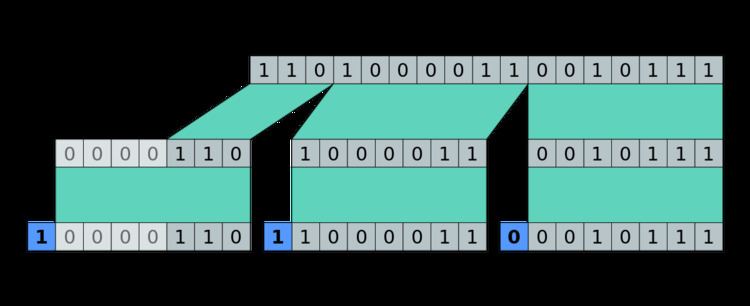 | ||
A variable-length quantity (VLQ) is a universal code that uses an arbitrary number of binary octets (eight-bit bytes) to represent an arbitrarily large integer. It was defined for use in the standard MIDI file format to save additional space for a resource constrained system, and is also used in the later Extensible Music Format (XMF). A VLQ is essentially a base-128 representation of an unsigned integer with the addition of the eighth bit to mark continuation of bytes. See the example below.
Contents
Base-128 is also used in ASN.1 BER encoding to encode tag numbers and Object Identifiers. It is also used in the WAP environment, where it is called variable length unsigned integer or uintvar. The DWARF debugging format defines a variant called LEB128 (or ULEB128 for unsigned numbers), where the least significant group of 7 bits are encoded in the first byte and the most significant bits are in the last byte (so effectively it is the little-endian analog of a variable-length quantity). Google's protocol buffers use a similar format to have compact representation of integer values, as does Oracle's Portable Object Format (POF) and the Microsoft .NET Framework's "7-bit encoded int" in the BinaryReader and BinaryWriter classes.
It's also used extensively in web browsers for source mapping - which contain a lot of integer line & column number mappings - to keep the size of the map to a minimum.
General structure
The encoding assumes an octet (an eight-bit byte) where the most significant bit (MSB), also commonly known as the sign bit, is reserved to indicate whether another VLQ octet follows.
If A is 0, then this is the last VLQ octet of the integer. If A is 1, then another VLQ octet follows.
B is a 7-bit number [0x00, 0x7F] and n is the position of the VLQ octet where B0 is the least significant. The VLQ octets are arranged most significant first in a stream.
Removing Redundancy
With the VLQ encoding described above, any number that can be encoded with N octets can also be encoded with more than N octets simply by prepending additional 0x80 octets. For example, the number 358 can be encoded as the 2-octet VLQ 0x8166 or the 3-octet VLQ 0x808166 or the 4-octet VLQ 0x80808166 and so forth.
However, the VLQ format used in Git removes this prepending redundancy and extends the representable range of shorter VLQs by adding an offset to VLQs of 2 or more octets in such a way that the lowest possible value for such an (N+1)-octet VLQ becomes exactly one more than the maximum possible value for an N-octet VLQ. In particular, since a 1-octet VLQ can store a maximum value of 127, the minimum 2-octet VLQ (0x8000) is assigned the value 128 instead of 0. Conversely, the maximum value of such a 2-octet VLQ (0xff7f) is 16511 instead of just 16383. Similarly, the minimum 3-octet VLQ (0x808000) has a value of 16512 instead of zero, which means that the maximum 3-octet VLQ (0xffff7f) is 2113663 instead of just 2097151. And so forth.
Other variants
In the data format for Unreal Packages used by the Unreal Engine, a variable length quantity scheme called Compact Indices is used. The only difference in this encoding is that the first VLQ has the sixth binary digit reserved to indicate whether the encoded integer is positive or negative.
If A is 0, then this is the last VLQ octet of the integer. If A is 1, then another VLQ octet follows.
If B is 0, then the VLQ represents a positive integer. If B is 1, then the VLQ represents a negative number.
C is a 6-bit number [0x00, 0x3F] and n is the position of the VLQ octet where C0 is the least significant. The VLQ octets are arranged most significant first in a stream.
Any consecutive VLQ octet follows the general structure.
Examples
Here is a worked out example for the decimal number 137:
Another way to look at this is to represent the value in base-128, and then set the MSB of all but the last base-128 digit to 1.
The Standard MIDI File format specification gives more examples:
